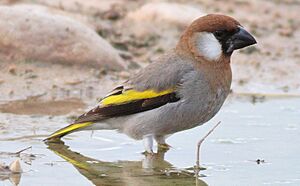Arabian golden-winged grosbeak facts for kids
Quick facts for kids Arabian golden-winged grosbeak |
|
|---|---|
 |
|
| Conservation status | |
| Scientific classification | |
| Genus: |
Rhynchostruthus
|
| Species: |
percivali
|
| Synonyms | |
|
Rhynchostruthus socotranus percivali |
|
The Arabian golden-winged grosbeak or Arabian grosbeak (Rhynchostruthus percivali) is a type of finch bird. It lives in parts of Saudi Arabia, Oman, and Yemen. Some experts used to think it was a subspecies of another bird. But now, most scientists agree that the three types of golden-winged grosbeaks are separate species.
What Does the Arabian Grosbeak Look Like?
Male Arabian golden-winged grosbeaks are mostly grey-brown. They have a black beak. Their head is brown with a dark grey "mask" around their eyes. They also have white cheeks. A special feature is their large, bright yellow patches. These patches are found on their wings and tail.
Female grosbeaks look a lot like the males. However, their colors are a bit less bright. Young grosbeaks, called juveniles, look different. They have streaky feathers. They also do not have the clear head pattern that adult birds have.
Where Does the Arabian Grosbeak Live and How Is It Doing?
The Arabian golden-winged grosbeak usually lives in areas that are high up. These places are between 1,060 and 2,800 meters (about 3,478 to 9,186 feet) above sea level. They prefer forested valleys, called wadis, and bushy areas.
Their home range includes Dhofar in Oman. It also covers the Mahra region of eastern Yemen. You can find them in the mountains of northern Yemen, reaching into Saudi Arabia. They have been seen as far north as Al Hara, near Ta'if, in Saudi Arabia.
In southwestern Saudi Arabia, these birds live in old East African Juniper forests. In Yemen, they have been seen in areas with spurge plants. They also live in woodlands with acacia and juniper trees. In the wooded Mahrah region, they mostly live in Anogeissus and Commiphora woodlands. The birds mainly eat the fruits from juniper, acacia, and spurge plants.
There are not many of these birds in their natural habitat. Scientists believe there are about 9,000 Arabian golden-winged grosbeaks left. Their numbers are going down. This is because their homes are being destroyed. Because of this, the bird is listed as a Near Threatened species. This means it might become endangered in the future. This listing was made in 2008 by the IUCN Red List.
See also
- National symbols of Yemen


